Overflowing flower beds, winding paths, and timeworn fences come together effortlessly in gardens that feel wild yet thoughtfully composed. With today’s push toward sustainable, pollinator-friendly landscapes, cottage-style gardens are seeing renewed appreciation for their informal charm and layered planting. They offer visual richness without requiring rigid symmetry or high-maintenance upkeep, making them an ideal fit for modern backyards craving softness and personality. Whether you’re starting fresh or working within an existing yard, incorporating elements of this style can breathe life into outdoor spaces. Keep reading for approachable, creative ideas that blend beauty, biodiversity, and that unmistakable cottage character in every detail.
Layered Planting with Mixed Heights
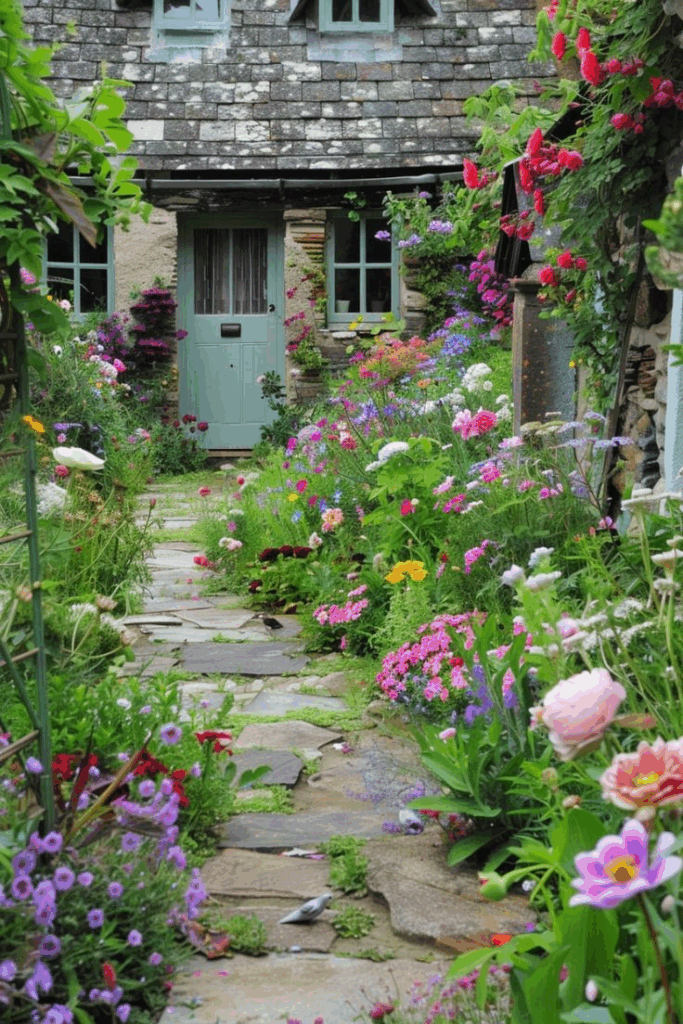
Blending various plant heights introduces depth and charm into any cottage garden layout. Tall hollyhocks or delphiniums set a dramatic backdrop, while mid-sized foxgloves and daisies bridge the visual gap to low-growing thyme or violas. This tiered arrangement isn’t just about aesthetics—it maximizes space and sunlight access for each plant type. Taller species can shield more delicate blooms from wind or harsh rays, promoting healthier growth. Integrating varying textures—from spiky alliums to feathery yarrow—keeps the garden lively through all seasons. By rotating bloom times across layers, gardeners enjoy continuous color without overcrowding. Mixing evergreen shrubs with perennials and annuals ensures visual interest even in off-seasons. This structured randomness mimics nature’s own balance while still offering curated beauty. For best results, use organic compost to boost soil richness and ensure proper root development. Spacing should consider full-grown plant width, not just current size, preventing future tangles. This method suits both narrow borders and larger plots. Repetition of certain varieties across the vertical layout maintains cohesion amid the variety. Ultimately, this technique turns an ordinary patch of earth into a dynamic floral tapestry where structure meets spontaneity—one that invites closer inspection and rewards the viewer with fresh details in every glance.
Incorporate Climbing Roses on Arbors
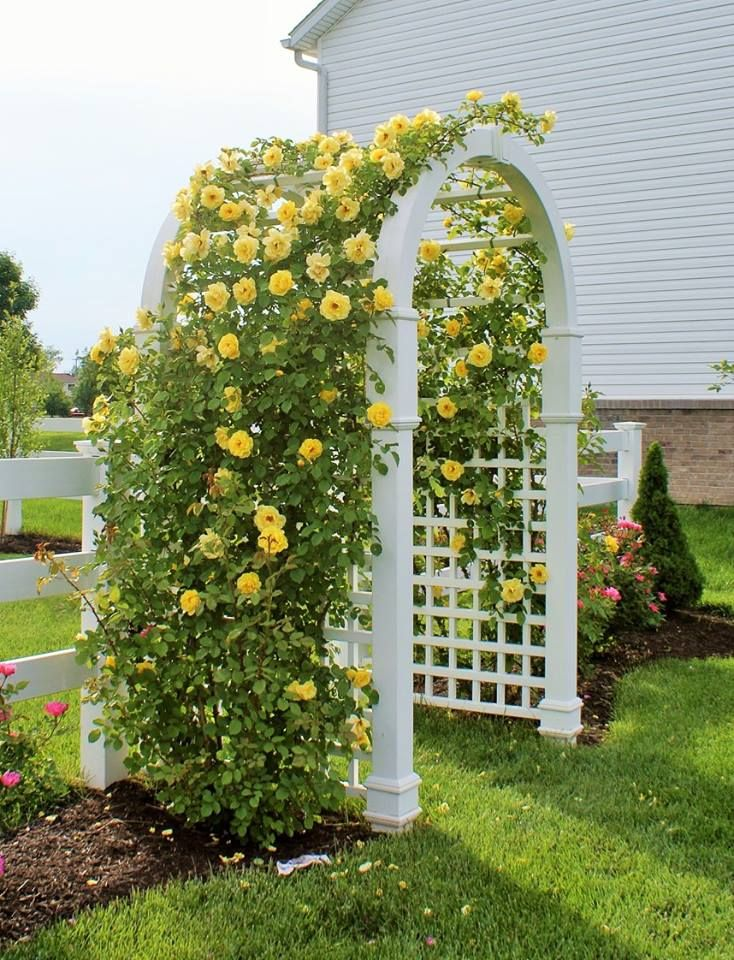
Draping fragrant climbing roses over arbors instantly brings storybook elegance to a cottage garden. Varieties like ‘New Dawn’ or ‘Eden’ offer soft, cascading blooms that arch gracefully over wood or wrought iron structures. This upward growth habit saves ground space while creating vertical drama and natural entryways. Proper support and pruning are essential—train stems horizontally along the arbor to encourage more lateral flowering. Select a location that receives six hours of sunlight daily and has well-draining soil to promote healthy canes and vibrant blooms. Pair with clematis or honeysuckle to intensify the layered floral effect and attract pollinators throughout the growing season. An arbor covered in climbing roses also acts as a natural privacy screen, defining pathways or secret nooks without the need for hard landscaping. As petals fall, they carpet the base below with delicate confetti, adding to the romantic aesthetic. Regular deadheading encourages repeat flowering and prevents disease. Mulch around the base retains moisture and suppresses weeds while protecting roots. This vertical element harmonizes beautifully with both formal layouts and relaxed plantings. Whether framing an entrance or defining a garden axis, rose-laden arbors elevate the ambiance, offering both visual delight and old-world charm with every bloom.
Use Vintage Garden Tools as Decor
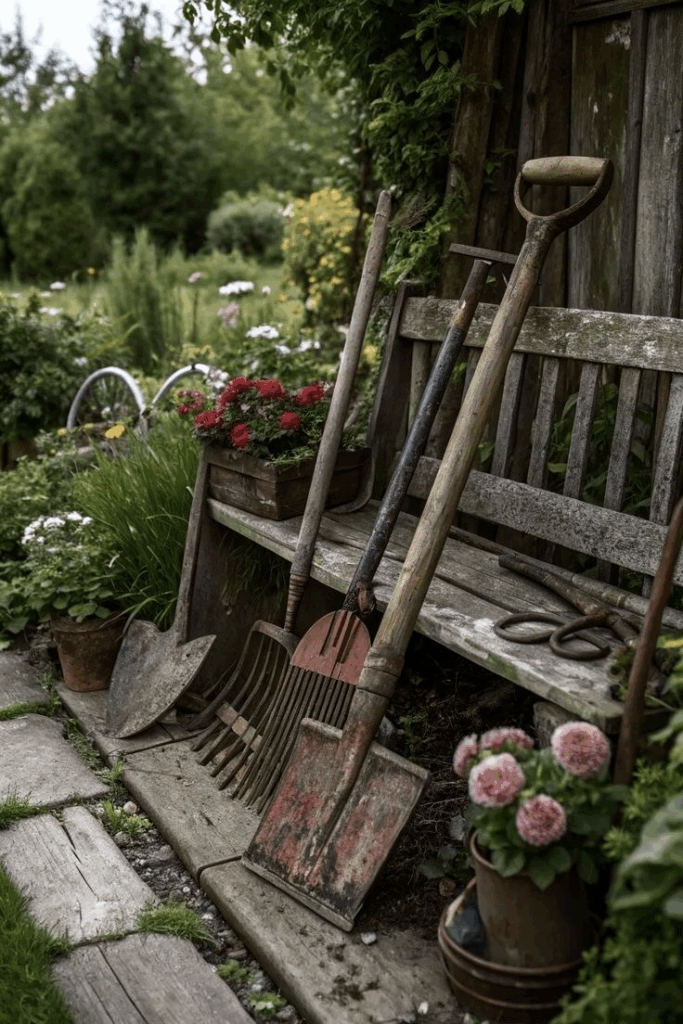
Old spades, rakes, and watering cans bring authenticity and charm when repurposed as outdoor accents. These relics, often found at flea markets or tucked away in barns, serve as nostalgic nods to simpler gardening traditions. Mounting rusted trowels on fences or leaning aged hoes against potting benches adds instant character without clutter. Functionality isn’t the focus—patina and weathered wood offer a rustic visual narrative. Drill holes into antique metal watering cans to convert them into hanging planters or let them stand solo among flower beds as sculptural pieces. Tools with broken handles become wall art, especially when arranged in a sunburst pattern or painted with floral motifs. Keep the placement intentional; scatter too many and the space risks looking chaotic. A small grouping at the garden entrance or near a bench subtly reinforces the theme without overwhelming the senses. Spray-sealing particularly delicate pieces helps preserve their look while resisting further decay. Paired with climbing vines or tucked into flower clusters, these vintage objects offer whimsy and storytelling in a way modern décor can’t replicate. For garden lovers who value heritage and handcrafted charm, incorporating worn tools into the design creates an inviting, lived-in look that connects past to present.
Create Meandering Stone Pathways
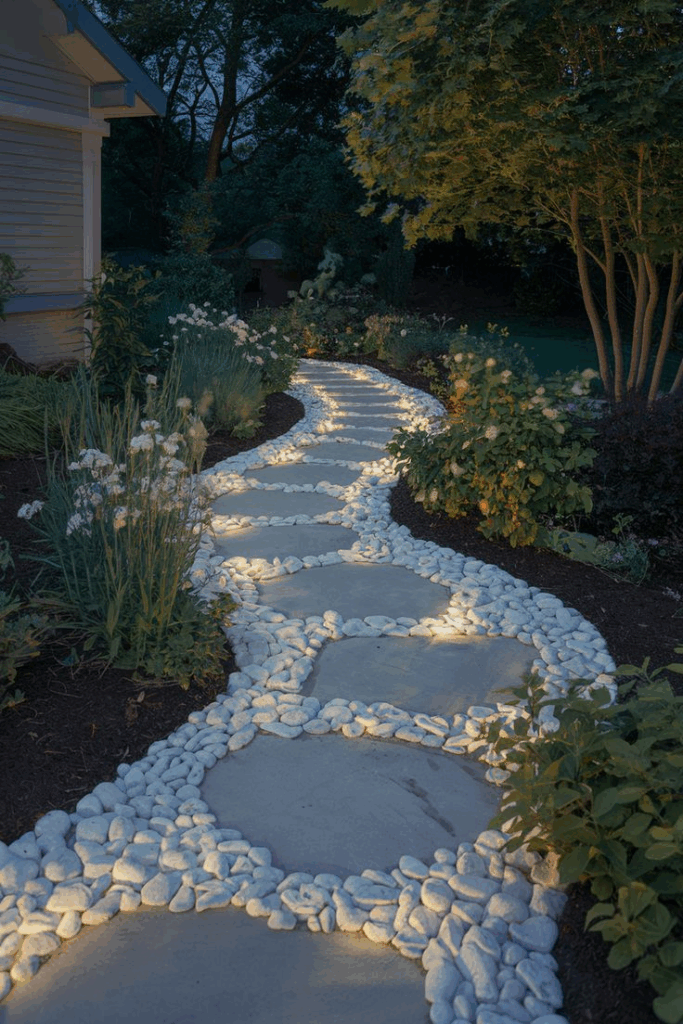
Winding paths carved with natural stones bring both structure and organic rhythm to cottage gardens. Unlike straight, formal walkways, a meandering route invites slow exploration, subtly guiding visitors through flower beds and shaded hideaways. Use irregularly shaped stones such as flagstone or fieldstone for an authentic, timeworn appearance. Interplanting with creeping thyme, moss, or low-growing sedum between the cracks softens hard edges and introduces fragrance underfoot. Gravel or crushed granite can be layered beneath to aid drainage and minimize weed intrusion. These paths not only offer visual flow but also protect soil from compaction, especially in high-traffic areas. Edging with bricks or recycled timber gives definition while preserving the pathway’s shape over time. Avoid overplanning—slight curves and varied widths feel more natural and reflect the relaxed spirit of cottage landscapes. Position stepping stones to highlight focal points, whether a garden sculpture, archway, or flowering shrub. Durability meets delight here: stone weathers beautifully and requires minimal maintenance beyond the occasional weed pull or reset. Lighting elements like solar lanterns or tea lights tucked alongside can transform these walkways into twilight enchantments. Thoughtfully constructed, these paths do more than connect—they narrate the journey through your garden’s evolving seasonal story.
Integrate Edible Plants Among Flowers
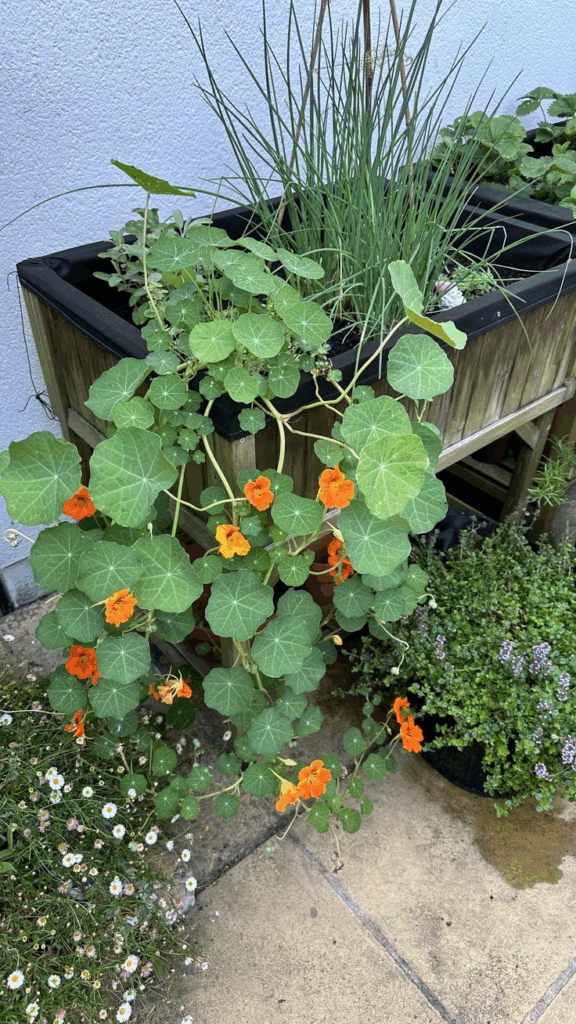
Blending edible herbs, vegetables, and fruiting plants into ornamental beds enriches both visual interest and practicality. Basil, kale, and Swiss chard provide texture and color that rival traditional foliage, while strawberries or cherry tomatoes offer charming pops of red. Calendula, borage, and nasturtium are dual-purpose stars, serving beauty and flavor in equal measure. Intermixing edibles with blooms like echinacea and cosmos encourages pollinator visits, improving both floral displays and crop yields. This approach maximizes space—ideal for smaller gardens where utility must meet aesthetics. Raised borders can contain lettuces, while climbing beans or peas can trail over arches, mimicking ornamental vines. Soil health remains crucial; regular composting ensures nutrients are replenished without relying on synthetic fertilizers. Harvesting becomes a visual delight rather than a utilitarian chore when produce is hidden among blooms. Companion planting also helps deter pests—marigolds near tomatoes or chives near roses offer natural protection. Rotating edible varieties each season prevents nutrient depletion and keeps the layout dynamic. Not only does this method support a more sustainable lifestyle, but it also encourages a deeper connection to both food and flora. For those craving beauty and bounty, edible-ornamental integration offers the best of both gardening worlds.
Install a Rustic Wooden Bench
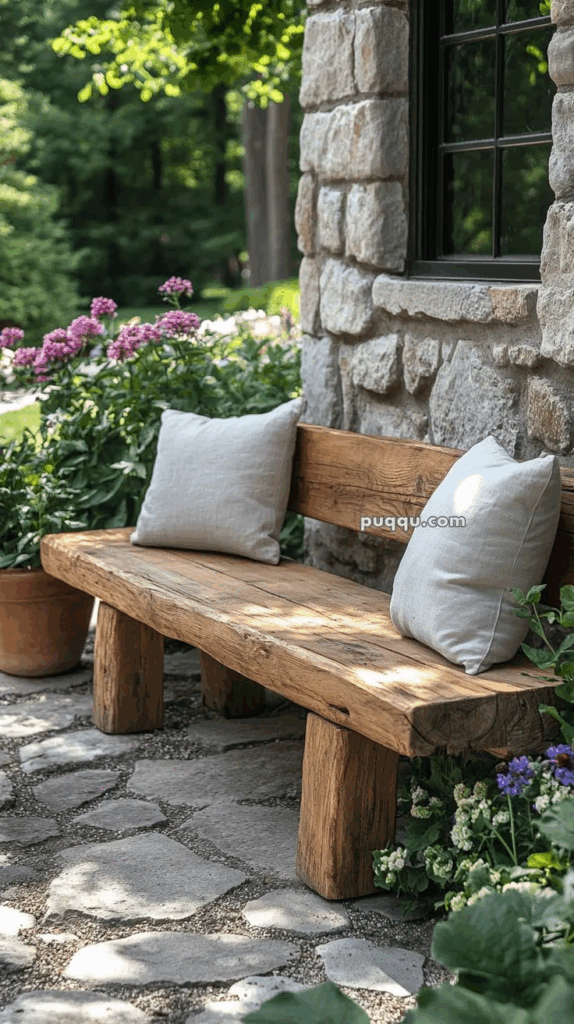
Strategically placing a weathered wooden bench adds both function and ambiance to a cottage garden. More than just a seat, it becomes a resting point for reflection and an intentional design feature that anchors the space. Choose untreated, reclaimed wood for its natural imperfections, allowing it to blend effortlessly with the surrounding flora. Over time, exposure to the elements enhances its patina, reinforcing the aged aesthetic. Nestle the bench beneath an arching tree or among tall grasses and perennials for a tucked-away feel. Surround with fragrant plants such as lavender, rosemary, or jasmine to amplify the sensory experience. Even simple planks supported by stacked stones can serve as a makeshift bench with timeless appeal. Regularly check for splinters or instability, especially after harsh weather. A clear sealant can extend the bench’s lifespan without compromising its rustic charm. Don’t over-decorate—let the bench speak through simplicity. Occasionally, add a neutral-toned cushion or throw for seasonal flair. This feature draws the eye and subtly invites visitors to pause, observe, and connect with the garden on a more intimate level. For any nature-inspired outdoor retreat, a rustic bench grounds the layout while offering a welcome invitation to slow down.
Add a Birdbath for Wildlife Attraction
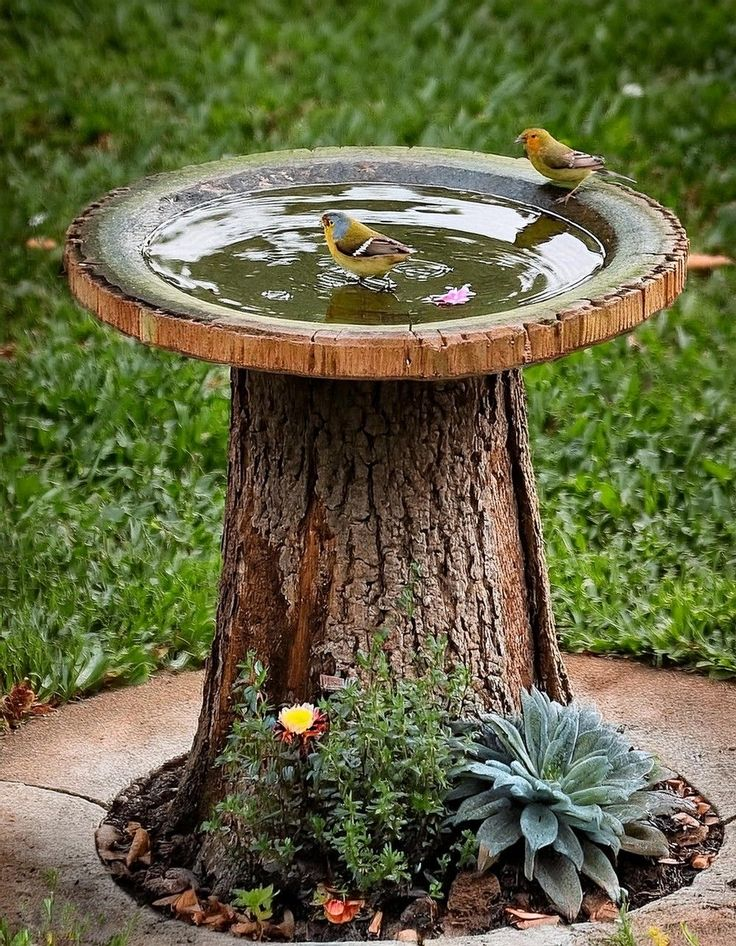
Welcoming birds into the garden enriches both ecosystem health and the garden’s tranquil ambiance. A stone or ceramic birdbath placed amid blooms encourages regular visits from finches, robins, and sparrows. Choose a shallow basin—ideally less than two inches deep—to ensure safety for smaller species. Frequent cleaning is key; stagnant water fosters algae and mosquito larvae, which can be detrimental to both birds and plants. Raised pedestals keep ground predators at bay, while placement near shrubs or small trees provides nearby perches and escape routes. Surrounding the base with nectar-rich flowers or low herbs like mint attracts butterflies and bees, creating a thriving mini-ecosystem. In colder regions, consider heated birdbaths to support wildlife through winter months. For visual harmony, opt for natural tones or weathered finishes that echo the garden’s informal style. Water movement—from gentle fountains to dripping stones—further entices visitors while masking neighborhood noise. During dry spells, birdbaths often become essential hydration stations for pollinators and small mammals. They’re more than décor—they’re lifelines. When carefully integrated, a birdbath becomes a quiet focal point, enriching the space with motion, sound, and the delightful flutter of wings. Its presence supports biodiversity while underscoring the peaceful rhythm of a true cottage garden.
Plant Lavender Borders for Fragrance
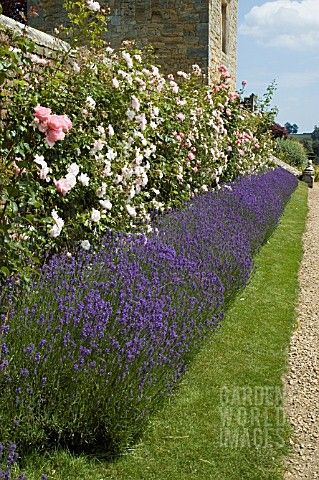
Fragrant borders define garden edges while offering visual softness and sensory delight. Lavender stands out as an ideal choice—resilient, pollinator-friendly, and deeply aromatic. Positioning it along paths or around beds creates a calming buffer that releases subtle scent with every breeze or brush. Its silvery-green foliage and purple blooms complement both muted and vibrant palettes, making it a versatile design element. Choose English lavender varieties like ‘Hidcote’ or ‘Munstead’ for compact growth and reliable blooming. Full sun and well-drained soil are essential; waterlogging can quickly lead to root rot. Annual pruning after flowering maintains shape and encourages dense regrowth. These borders also serve functional purposes: they deter deer, attract bees, and repel certain garden pests. Plant spacing of about 18–24 inches allows airflow while forming a cohesive hedge over time. Interspersing with companion plants such as yarrow or rosemary adds textural contrast while preserving the aromatic theme. During peak bloom, lavender-lined paths become a multisensory experience—visually striking and soothingly fragrant. Even in winter, its evergreen base adds structure. By anchoring your garden’s edge with lavender, you ensure year-round charm wrapped in a scent that evokes countryside calm with every step.
Utilize Antique Containers for Planters
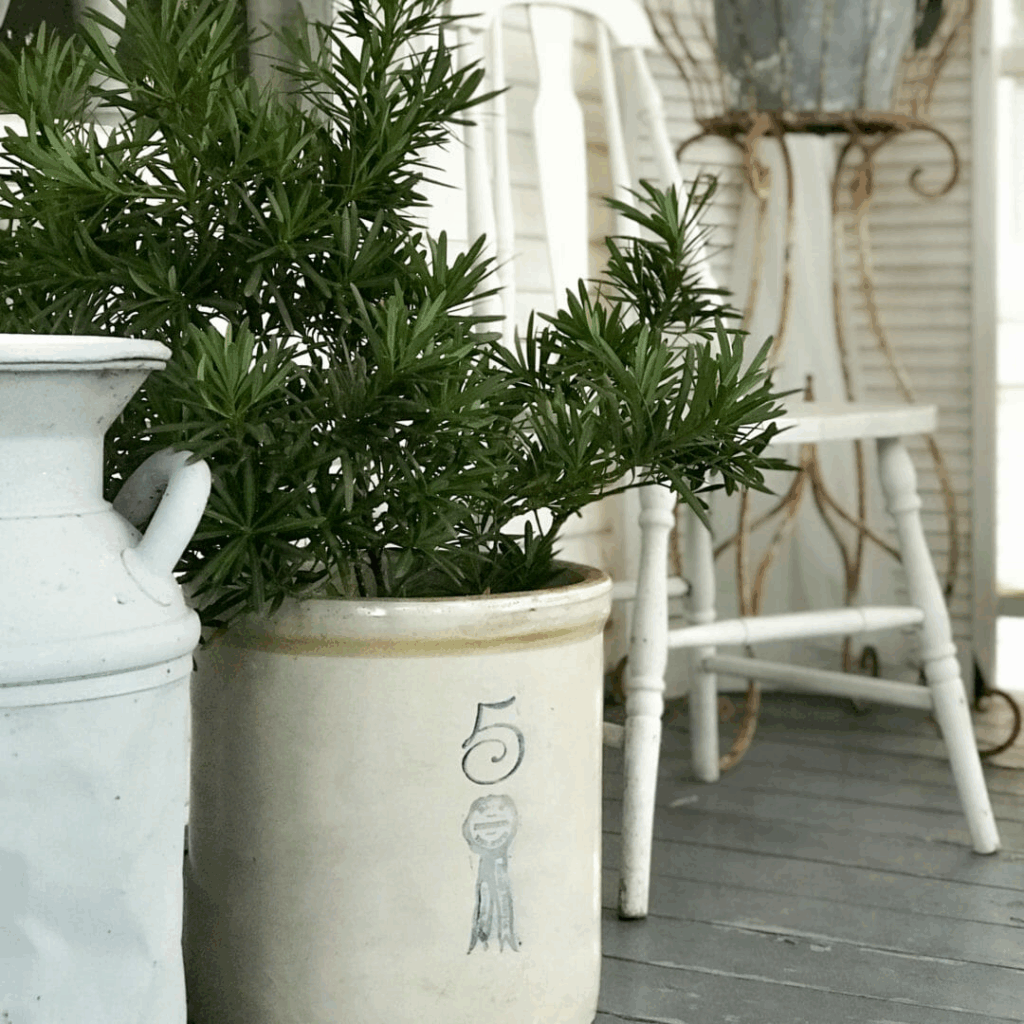
Unexpected vessels can elevate plant displays from ordinary to delightfully nostalgic. Repurposing vintage tins, enamel basins, teapots, or milk cans brings unique character to container gardening. These items often boast weathered textures, muted patinas, or decorative details that modern planters lack. Drainage is critical—either drill holes or add a layer of pebbles to avoid root rot. Herbs, trailing ivy, pansies, or succulents thrive in these contained micro-environments. Grouping several varied containers on steps, shelves, or rustic carts creates a curated vignette that draws attention and tells a story. Keep color schemes cohesive to prevent visual clutter—think whites, rusts, and soft pastels. Each planter becomes a conversation piece, blurring the line between utility and ornamentation. These antique accents integrate effortlessly into cottage aesthetics, reflecting a mindset of resourcefulness and charm. Rotate plantings seasonally for freshness without changing the containers themselves. Weather-resistant sealants can protect fragile materials from degrading outdoors, especially in wetter climates. Embracing this approach reduces waste while adding unreplicable charm. It’s an homage to vintage simplicity, where even discarded objects gain second life as cradles for blooming life. When scattered through a garden, antique planters create delightful surprises tucked among foliage and flowers.
Design a Secluded Seating Nook
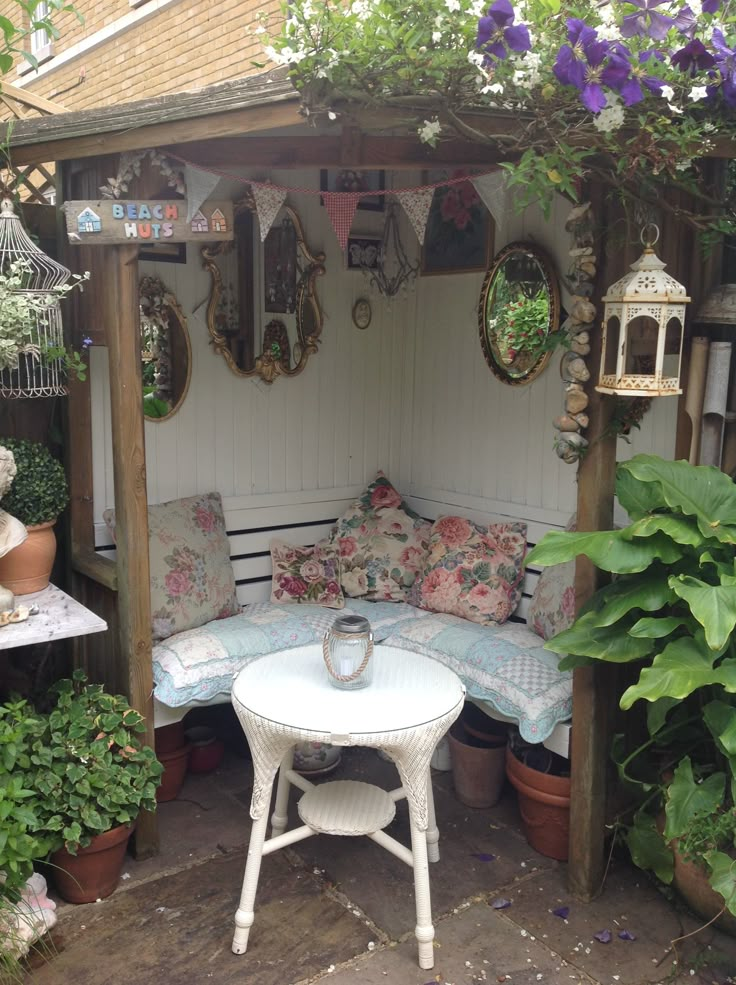
Every cottage garden benefits from a quiet corner where one can rest, read, or simply enjoy the setting. Tucked behind tall hollyhocks, within a leafy alcove, or framed by an overgrown trellis, such spaces offer privacy without isolation. Use natural dividers like climbing vines on trellises, espaliered trees, or tall ornamental grasses to form a soft enclosure. Gravel underfoot, a simple bench, and a few potted plants can transform even a narrow spot into a peaceful escape. Avoid overfurnishing—let the greenery set the mood. If the area gets morning sun, add a small table for breakfast or journaling; if it’s shadier, consider mossy groundcovers for an enchanted touch. Wind chimes or a bubbling water bowl can enhance the atmosphere. For evening use, solar string lights or lanterns create ambient glow without electricity. Placement is key—choose a nook where foot traffic is minimal, but views of favorite garden features remain accessible. This design element isn’t just about aesthetics—it promotes mindfulness and slower living. Whether nestled beside roses or hidden beneath climbing wisteria, a secluded seating nook offers more than comfort; it invites connection with the surrounding nature on a deeply personal level.
Implement a White Picket Fence
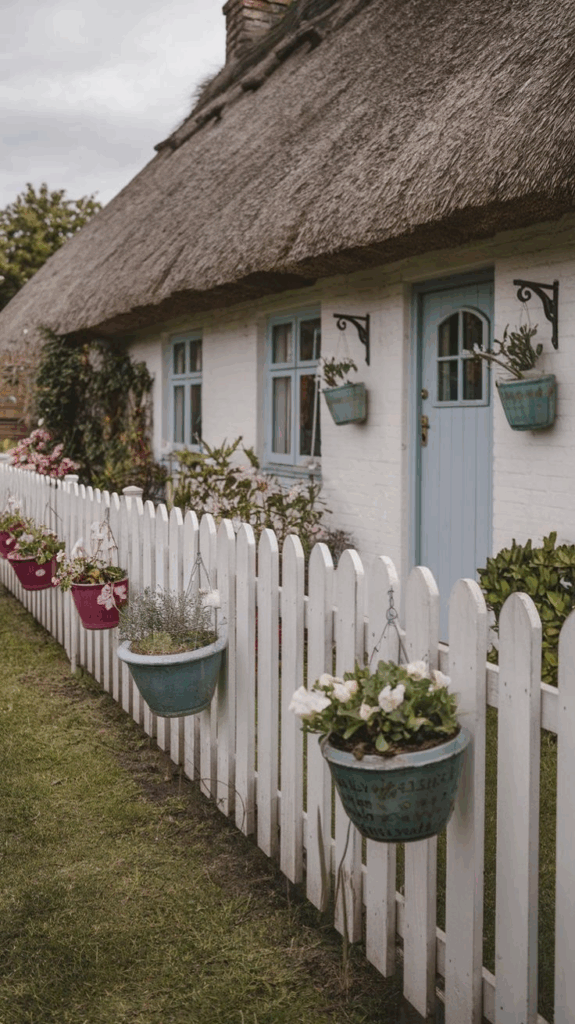
Classic and functional, a white picket fence defines the perimeter of a cottage garden while enhancing its visual charm. This traditional element frames blooming beds like a picture, offering contrast that highlights color and form. Unlike solid walls, pickets provide subtle division without obstructing airflow or sunlight. Painted white, they reflect light and brighten the space—particularly useful in smaller plots. Spacing between pickets should allow climbing plants like sweet peas or morning glories to weave through naturally. Maintenance includes annual touch-ups or weatherproof paint to combat wear. Cedar or pressure-treated wood ensures durability against moisture and insects. Gateways within the fencing can be accented with arching roses or clematis for inviting entry points. Aside from aesthetics, fencing also keeps pets or children safely within bounds while deterring unwanted garden tramplers. When scaled correctly, it supports the informal structure that defines cottage gardens—organized but free-spirited. Even modest fencing along a single path or bed edge can lend cohesion to disparate plantings. Though simple in form, this feature anchors the entire garden, blending nostalgia with function. Its enduring popularity lies in its ability to feel both fresh and familiar, marrying design and utility in a single stroke.
Include Self-Seeding Annuals
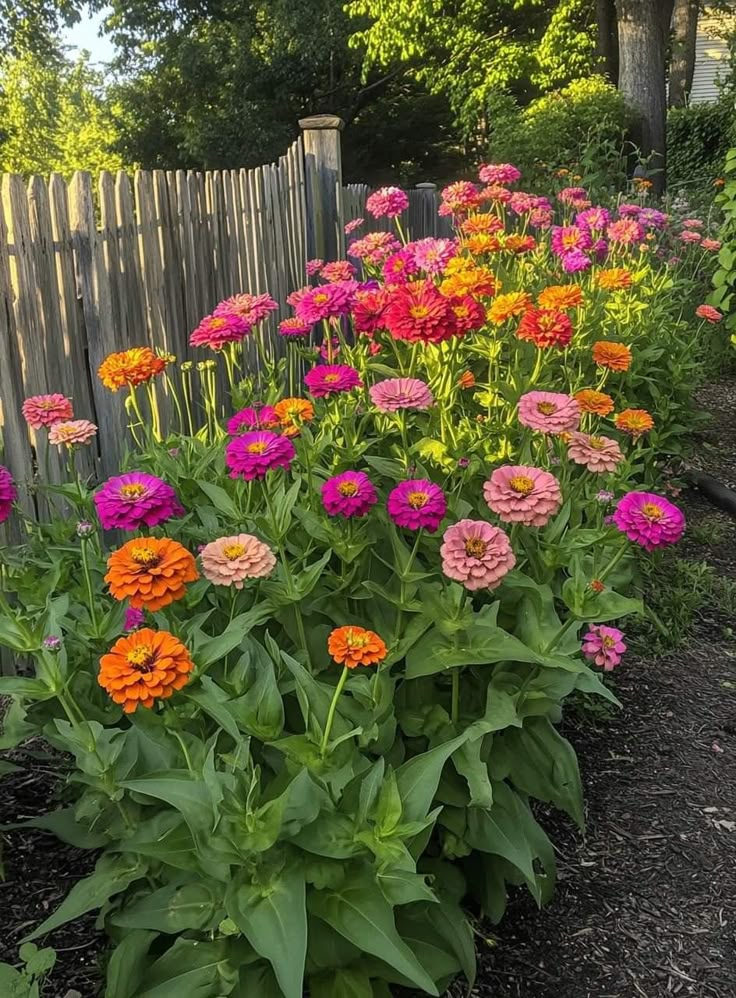
Plants that reseed themselves contribute to the dynamic, ever-changing beauty of a true cottage garden. Varieties like cosmos, poppies, nigella, and larkspur scatter seeds naturally, popping up in unexpected corners season after season. This self-propagation encourages a more natural, loose planting style that feels spontaneous and alive. Once established, these annuals reduce the need for replanting, making them budget-friendly and low-maintenance. Soil should remain slightly undisturbed—avoid excessive mulching or turning the beds—which allows seeds to settle and sprout reliably. Select open-pollinated species to ensure that successive generations maintain desirable traits. Mixing self-seeders with more permanent plantings helps fill gaps as perennials fade or go dormant. Letting a few spent blooms go to seed is key—don’t deadhead everything. Consider weather conditions, as heavy rain or strong winds can wash away seeds before they germinate. Be prepared to edit with light thinning in spring to prevent overcrowding. The joy lies in surprise—watching where new patches emerge and how colors shift subtly each year. This approach fosters a wilder, more romantic atmosphere that defines cottage style. Through minimal intervention, the garden becomes a living canvas, painting itself anew each season in playful, unplanned patterns.
Feature a Weathered Garden Gate
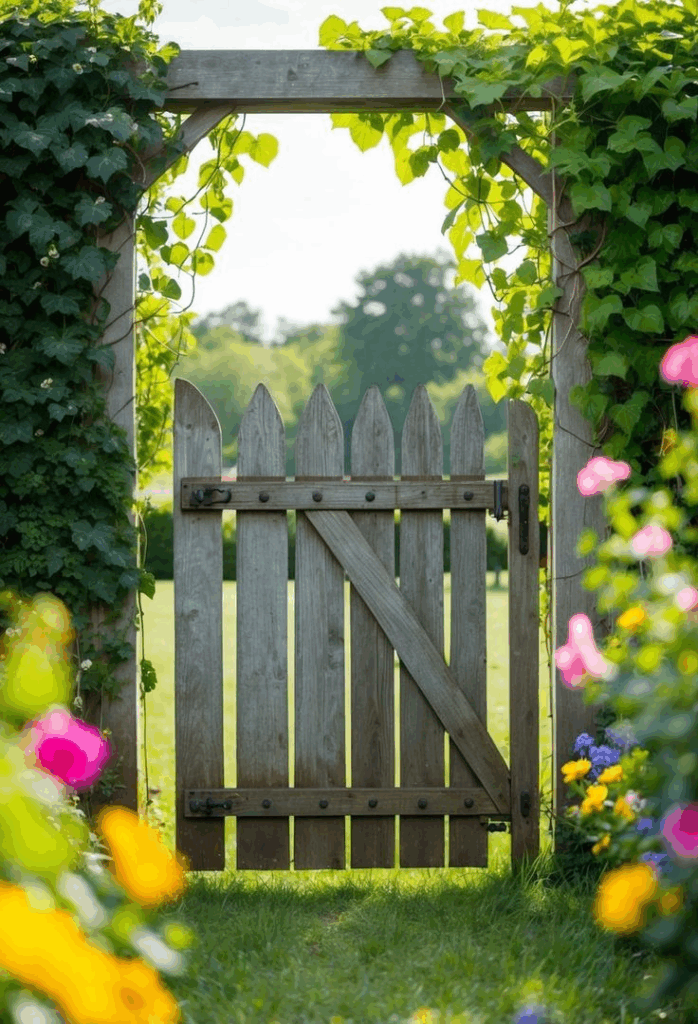
A garden gate does more than mark an entry—it sets a tone. When aged by time or styled with distressed finishes, it becomes a character piece that hints at secrets within. Whether wooden, wrought iron, or a blend of materials, the gate should feel like it belongs to the story of the space. Position it where paths begin or divide, anchoring key transitions in the garden layout. Adorn with climbing clematis or rambling roses to soften its lines and visually connect it to surrounding growth. Functional hardware like iron latches or hinges enhances the vintage effect while ensuring durability. Frequent exposure to the elements contributes patina and texture—both desirable in cottage aesthetics. Consider painting the gate in muted colors such as sage, sky blue, or classic white, depending on your broader palette. A creaking sound or overgrown foliage only adds to the charm. While gates may be symbolic, they also provide structure, defining the edge between cultivated beauty and wild growth. Beyond its function, a garden gate frames views, inviting curiosity and beckoning visitors further. It embodies the welcoming, slightly whimsical nature of a cottage garden—where structure and spontaneity meet under a veil of green.
Incorporate a Small Water Feature
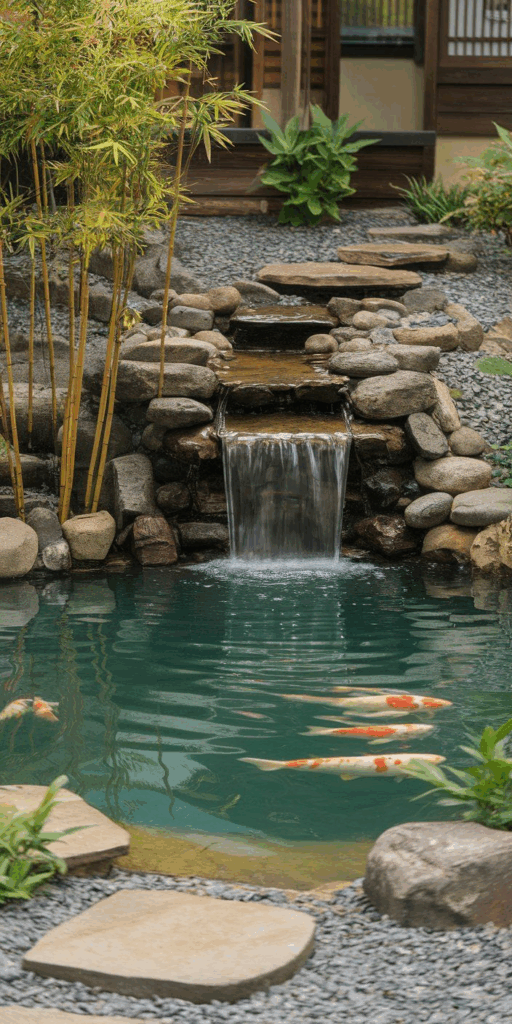
Introducing a compact water feature adds both serenity and sensory richness to garden spaces. Bubbling fountains, still basins, or small stone ponds reflect light and attract birds, butterflies, and frogs, enhancing biodiversity. Even a vintage bowl or ceramic pot with a submerged pump can simulate gentle movement. Place it where it will be enjoyed—near a seating area, tucked into a floral border, or beside a winding path. The trickle of water provides a soothing backdrop that softens city noise and encourages mindful pauses. Select natural materials—stone, copper, or weathered ceramic—to keep the look in harmony with surrounding plants. Ensure a nearby power source if using pumps, or opt for solar-powered versions for efficiency. Regular cleaning keeps algae and debris in check, especially in shaded areas. Avoid overly ornate designs; simplicity preserves authenticity. For dry climates, consider a recirculating system that conserves water. Aquatic plants such as water lettuce or miniature water lilies introduce greenery while maintaining oxygen levels. These features don’t need to dominate the space—they enhance it quietly, offering calm in motion and inviting small life forms to linger. Within a cottage garden, even the subtlest water element feels magical, as though part of the landscape all along.
Use Reclaimed Materials for Garden Structures

Building garden features with salvaged wood, bricks, or iron lends authenticity while reducing waste. Arches, trellises, potting tables, or fencing made from repurposed materials age gracefully and echo the historical roots of cottage gardening. Each piece carries its own story—weathered textures, faded paint, or rough edges that modern items often lack. Seek out architectural salvage yards or old barns for sourcing. Structural integrity should remain a priority; reinforce where needed, but let imperfections remain. Pairing these materials with flowering vines, herbs, or trailing plants lets nature soften the man-made framework. Uneven stones can become charming paths, and old doors serve as quirky backdrops for vertical plantings. Even cracked terra cotta pots gain new purpose as drainage layers or mosaic elements. This approach champions sustainability without sacrificing beauty. Use natural finishes to seal porous surfaces and prevent rot. The visual continuity of reused textures supports a cohesive garden story—one of renewal, character, and intention. These elements foster a handcrafted look that can’t be replicated with new store-bought kits. Through thoughtful placement and honest aging, reclaimed materials elevate garden design into a soulful expression of time and place.
